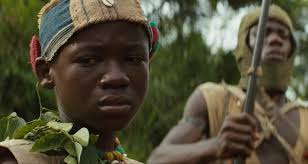Let me tell you about the surface narrative of the film for a bit. Then, I'll tell you about the other story I got out of Dheepan.
This Palm D'or winner from Jacques Audiard is constructed with a clear, traditional three parts arc. In the beginning, we see a Tamil Tiger soldier seeking escape from death and destruction in his home land. That journey begins with a necessary lie: he arrives in France with a family not his own, cobbled together from the ruins of survivors, the witnesses of human destruction. They begin their new life in what seems to be a project housing in the middle of Nowhere, France. In the second arc, our protagonist and his faux family try to figure out their new place in the current world, and we get the usual immigrant fish-out-of-water dramedy. For a while, they could pretend it's like "a movie" (as the wife character says), watching but not really being a part of it. It doesn't last, of course, as violence is embedded within their new life as well, always threatening to surface. The drama of three strangers trying to survive together unfolds as expected, and the third act deals with the inevitable disintegration of this fragile tapestry.
There's a richness to the number of possible stories here: the immigrant experience, survivors of wars, senseless violence and destruction in modern life. All of them, however, leave a bit to be desired. Each seems a little less interesting as a film on its own, without elements of other stories. As such, any interpretation relying on these separate stories may leave you wondering, "what's the big deal?" Where's the "truth", so to speak, to this exercise?
Perhaps, the truth is painted on the elephant in the film, figuratively and literally speaking.
On two separate occasions, the head of a speckled elephant appears, demarcating the middle arc from the first and the third one. Any time an animal is used in the film, it's a cued entry into the spiritual / psychological world. Without fail, as in A Prophet (Audiard's previous film that I've seen), here lies what I believe to be the experiential truth. Forget the other stories; let's retrace our step.
SPOILERS ALERT
Dheepan, one must remember, is a false name. He carries with him the trauma of the burned dead, into what is essentially a No Man's Land (at one point he declares a No Fire Zone in the film), or as it is called in the film, Le Pre (the Field). This Field, nondescript and full of lost souls, is a false world. Here, he exists without living (the film made a point of him having no sense of humour), a purgatory of sort. From a psychological point of view, trauma survivors live in a sort of limbo state of experience. The past haunts the present; every day life is a little removed, a little surreal, and always threatened by the possibility of being subsumed by what the survivors carry with them. One can also map this holding place onto the adjustment period for new immigrants, wherein the displaced people haven't quite yet found their true "present," holding onto the home land in their memory while waiting for admission into their new cultural home.
Emotion-Focused Therapy theory postulates that to have a healthy psyche again, to be able to live fully in the present experience, one needs to "correct" the maladaptive emotional experience as it is being experienced. The correction begins with the allowance for the painful, emotional experience to come alive in the present. Out of it rise the unspoken human needs and desires unmet. The correction completes with an integrated experience of the self, and a new narrative emerges from the crumbled haunts of the past.
Dheepan's pain of having lost loved ones is allowed to come alive in his new family and the new, yet familiar place of violence and disconnection. This kind of pain is a lonely one: he screams, sings, and loses control on his own at first. It is only when the circumstances present an opportunity for him to act out what he probably wishes to have done or admonishes himself for not having done, that his spirit/psyche rises to the occasion (literally up the stairs), and the need to reconnect to humanity is met. Only then, the angels sing, signalling the leaving of this limbo phase, and the arrival of a new beginning.
As it exists on this plane, the film is a beautifully realized and constructed story. Sometimes, it helps to dig a little deeper when struggling with "is this it?" coming out of a film. It may or may not place the film in a different context that's perhaps more rewarding for the viewer. There just has to be enough in the experience itself to warrant the exploration, and the elephant does it for Dheepan.
Read More...
Summary only...
 Subscribe
Subscribe



